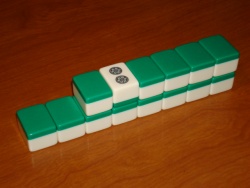Wanpai
Wanpai 「王牌」 are the tiles used to form the dead wall, a set of 14 tiles (7 double-stacks) set aside from the regular tile draw and discard processes. At the start of each hand, a new group of 14 tiles are randomly picked. These tiles are used to indicate dora and for kan draws.
Arrangement

The fourteen tiles for the dead wall are arranged accordingly. Also, the last four tiles to the live wall are also included.
| Dead wall | End of live wall | ||||||||
|---|---|---|---|---|---|---|---|---|---|
| 1st kan draw | 3rd kan draw | Dora indicator | 1st kandora | 2nd kandora | 3rd kandora | 4th kandora | 2nd haiteihai | 4th haiteihai | |
| 2nd kan draw | 4th kan draw | 1st uradora | 2nd uradora | 3rd uradora | 4th uradora | 5th uradora | 1st haiteihai | 3rd haiteihai | |
The dead wall always starts with this arrangement. The kan draws are always the four tiles clockwise to the dora indicator.
Optionally, the first kan draw can be placed to the side of the second kan draw, like in the image to the right, to prevent accidental revealing if it gets knocked off.
Dora
The dead wall is always responsible for indicating the dora. At the start of each hand, the third tile on the top row is revealed and becomes the dora indicator (dorahyouji' 「ドラ表示」). The tile one number up from the revealed tile is the dora.
- For every kan, the next tile from the wall break is revealed and becomes another dora indicator.
- After a player wins with riichi, any tiles underneath each revealed dora indicator are revealed and become ura dora indicators.
Haiteihai
The tile immediately before the dead wall is called the haiteihai 「海底牌」. When a kan is made, the current haiteihai will become part of the dead wall, and the tile before it becomes the new haiteihai. (The tile may be physically moved after a kan, but this is discouraged as it is unnecessary.)
The position of the last tile can be tracked as the hand nears the end. As a general tip, the last tile is trackable by counting six tiles on the top of the dead wall, if the rinshan draw is properly placed.
Kan
Calls for kan affect the dead wall in three ways:
- The player calling kan is then required to draw from the dead wall via the rinshanpai.
- A tile from the back end of the wall, the haiteihai, is transferred to the dead wall.
- The tile next to the dora is revealed.
For every kan call, a player gains access to the dead wall and draws one rinshanpai. If the rinshanpai produces a winning tile, then this draw invokes the yaku, rinshan kaihou. Under most cases, players make a discard afterwards. After that discard, one tile from the end of the regular wall is added to the dead wall to the back end. This is to retain the count of 14-tiles. Unlike the original dead wall tiles, the added tiles can serve no function, other than as replacement tiles. Finally, an additional dora indicator is revealed.
External links
- Wanpai in Japanese Wikipedia